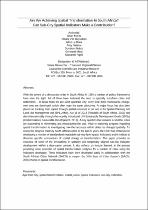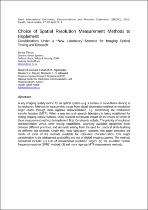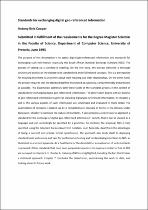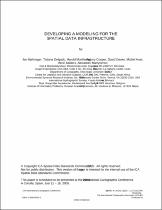 ResearchSpace
ResearchSpace
Are we achieving spatial transformation In South Africa? Can sub-city spatial indicators make a contribution?
JavaScript is disabled for your browser. Some features of this site may not work without it.
- ResearchSpace
- →
- Research Publications/Outputs
- →
- Conference Publications
- →
- View Item
| dc.contributor.author |
Maritz, Johan

|
|
| dc.contributor.author |
Van Huyssteen, Elsona

|
|
| dc.contributor.author |
Le Roux, Alize

|
|
| dc.contributor.author |
Pieterse, Amy

|
|
| dc.contributor.author |
Ndaba, Dumisani

|
|
| dc.contributor.author |
Mans, Gerbrand G

|
|
| dc.contributor.author |
Ngidi, Mawande

|
|
| dc.date.accessioned | 2017-06-07T08:03:21Z | |
| dc.date.available | 2017-06-07T08:03:21Z | |
| dc.date.issued | 2016-06 | |
| dc.identifier.citation | Maritz, J., Van Huyssteen, E., Le Roux, A. et al. 2016. Are we achieving spatial transformation In South Africa? Can sub-city spatial indicators make a contribution? South African Planning Institute (SAPI): Planning Africa Conference 2016: Making Sense of the Future, 3-6 June 2016, Sandton Convention Centre, Johannesburg, South Africa | en_US |
| dc.identifier.isbn | 978-0-620-69628-9 | |
| dc.identifier.uri | http://stepsa.org/pdf/planning_africa_2016/PAC_Spatial_Transformation_Indicators_JMfin.pdf | |
| dc.identifier.uri | ttp://www.planningafrica.org.za/sites/default/files/SAPI_AbstractBook2016.pdf | |
| dc.identifier.uri | http://hdl.handle.net/10204/9244 | |
| dc.description | South African Planning Institute (SAPI): Planning Africa Conference 2016: Making Sense of the Future, 3-6 June 2016, Sandton Convention Centre, Johannesburg, South Africa | en_US |
| dc.description.abstract | With the advent of a democratic order in South Africa in 1994 a number of policy frameworks have seen the light. All of these have indicated the need to spatially transform cities and settlements – to break from the pre-1994 apartheid city. Over time these frameworks change, new ones are developed which often state the same objectives. A major focus has also been placed on tracking their impact through spatial outcomes as set out in the Spatial Planning and Land Use Managemnet Act (SPLUMA), Act 16 of 2013 (Republic of South Africa, 2013) and also internationally through the recently introduced UN Sustainable Development Goals (SDGs) (United Nations Sustainable Development, 2016). A key question that remains is whether cities are succeeding in reinventing and restructuring the past. Vital in exploring progress regarding spatial transformation is investigating how the landscape within cities has changed spatially. To assess the progress made by South African cities in the last 20 years, the CSIR has embarked on developing a number of standardised repeatable sub-city level spatial indicators and/or indices to illustrate specific components of spatial change or transformation. This paper provides an overview of some of the innovations in spatially and temporally aligned sub-city indicator development within a data-scarce context. It also reflects on lessons learned, in the process providing some examples of spatial transformation analyses for a number of cities using the indicators developed. These Indicators have been developed partly in collaboration with the South African Cities Network (SACN) to support the 2016 State of Cities Report’s (SACN, 2016) theme on spatial transformation. | en_US |
| dc.language.iso | en | en_US |
| dc.publisher | stepsa.org | en_US |
| dc.relation.ispartofseries | Worklist;18083 | |
| dc.subject | Apartheid city | en_US |
| dc.subject | Spatial transformation | en_US |
| dc.subject | Spatial justice | en_US |
| dc.subject | Spatial indicators | en_US |
| dc.subject | Sub-city | en_US |
| dc.title | Are we achieving spatial transformation In South Africa? Can sub-city spatial indicators make a contribution? | en_US |
| dc.type | Conference Presentation | en_US |
| dc.identifier.apacitation | Maritz, J., Van Huyssteen, E., Le Roux, A., Pieterse, A., Ndaba, D., Mans, G. G., & Ngidi, M. (2016). Are we achieving spatial transformation In South Africa? Can sub-city spatial indicators make a contribution?. stepsa.org. http://hdl.handle.net/10204/9244 | en_ZA |
| dc.identifier.chicagocitation | Maritz, Johan, Elsona Van Huyssteen, Alize Le Roux, Amy Pieterse, Dumisani Ndaba, Gerbrand G Mans, and Mawande Ngidi. "Are we achieving spatial transformation In South Africa? Can sub-city spatial indicators make a contribution?." (2016): http://hdl.handle.net/10204/9244 | en_ZA |
| dc.identifier.vancouvercitation | Maritz J, Van Huyssteen E, Le Roux A, Pieterse A, Ndaba D, Mans GG, et al, Are we achieving spatial transformation In South Africa? Can sub-city spatial indicators make a contribution?; stepsa.org; 2016. http://hdl.handle.net/10204/9244 . | en_ZA |
| dc.identifier.ris | TY - Conference Presentation AU - Maritz, Johan AU - Van Huyssteen, Elsona AU - Le Roux, Alize AU - Pieterse, Amy AU - Ndaba, Dumisani AU - Mans, Gerbrand G AU - Ngidi, Mawande AB - With the advent of a democratic order in South Africa in 1994 a number of policy frameworks have seen the light. All of these have indicated the need to spatially transform cities and settlements – to break from the pre-1994 apartheid city. Over time these frameworks change, new ones are developed which often state the same objectives. A major focus has also been placed on tracking their impact through spatial outcomes as set out in the Spatial Planning and Land Use Managemnet Act (SPLUMA), Act 16 of 2013 (Republic of South Africa, 2013) and also internationally through the recently introduced UN Sustainable Development Goals (SDGs) (United Nations Sustainable Development, 2016). A key question that remains is whether cities are succeeding in reinventing and restructuring the past. Vital in exploring progress regarding spatial transformation is investigating how the landscape within cities has changed spatially. To assess the progress made by South African cities in the last 20 years, the CSIR has embarked on developing a number of standardised repeatable sub-city level spatial indicators and/or indices to illustrate specific components of spatial change or transformation. This paper provides an overview of some of the innovations in spatially and temporally aligned sub-city indicator development within a data-scarce context. It also reflects on lessons learned, in the process providing some examples of spatial transformation analyses for a number of cities using the indicators developed. These Indicators have been developed partly in collaboration with the South African Cities Network (SACN) to support the 2016 State of Cities Report’s (SACN, 2016) theme on spatial transformation. DA - 2016-06 DB - ResearchSpace DP - CSIR KW - Apartheid city KW - Spatial transformation KW - Spatial justice KW - Spatial indicators KW - Sub-city LK - https://researchspace.csir.co.za PY - 2016 SM - 978-0-620-69628-9 T1 - Are we achieving spatial transformation In South Africa? Can sub-city spatial indicators make a contribution? TI - Are we achieving spatial transformation In South Africa? Can sub-city spatial indicators make a contribution? UR - http://hdl.handle.net/10204/9244 ER - | en_ZA |








